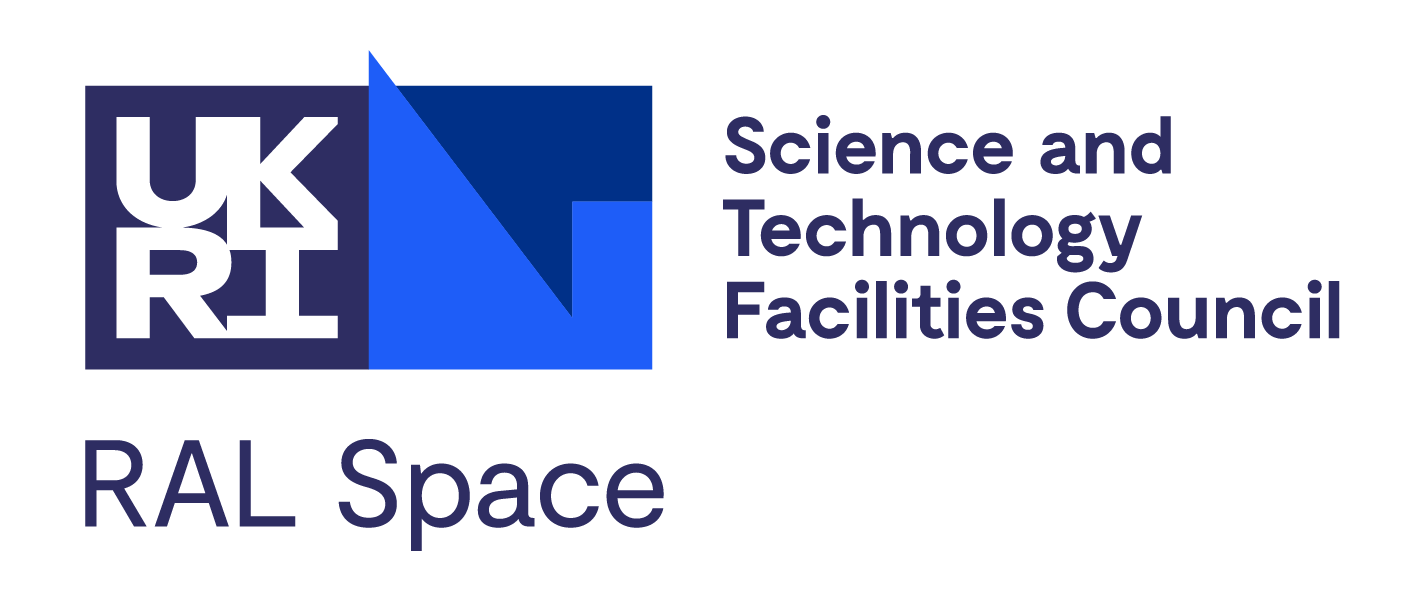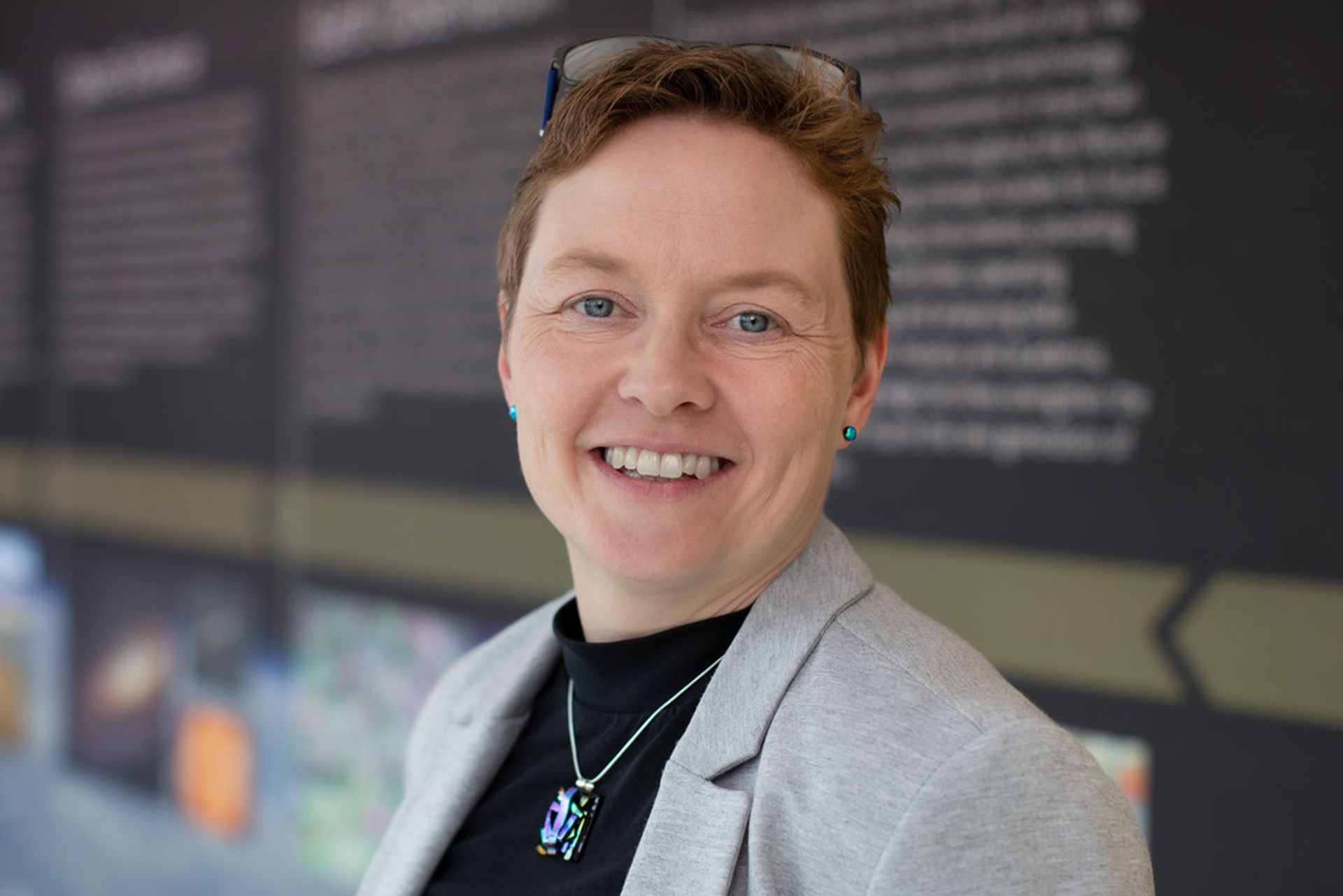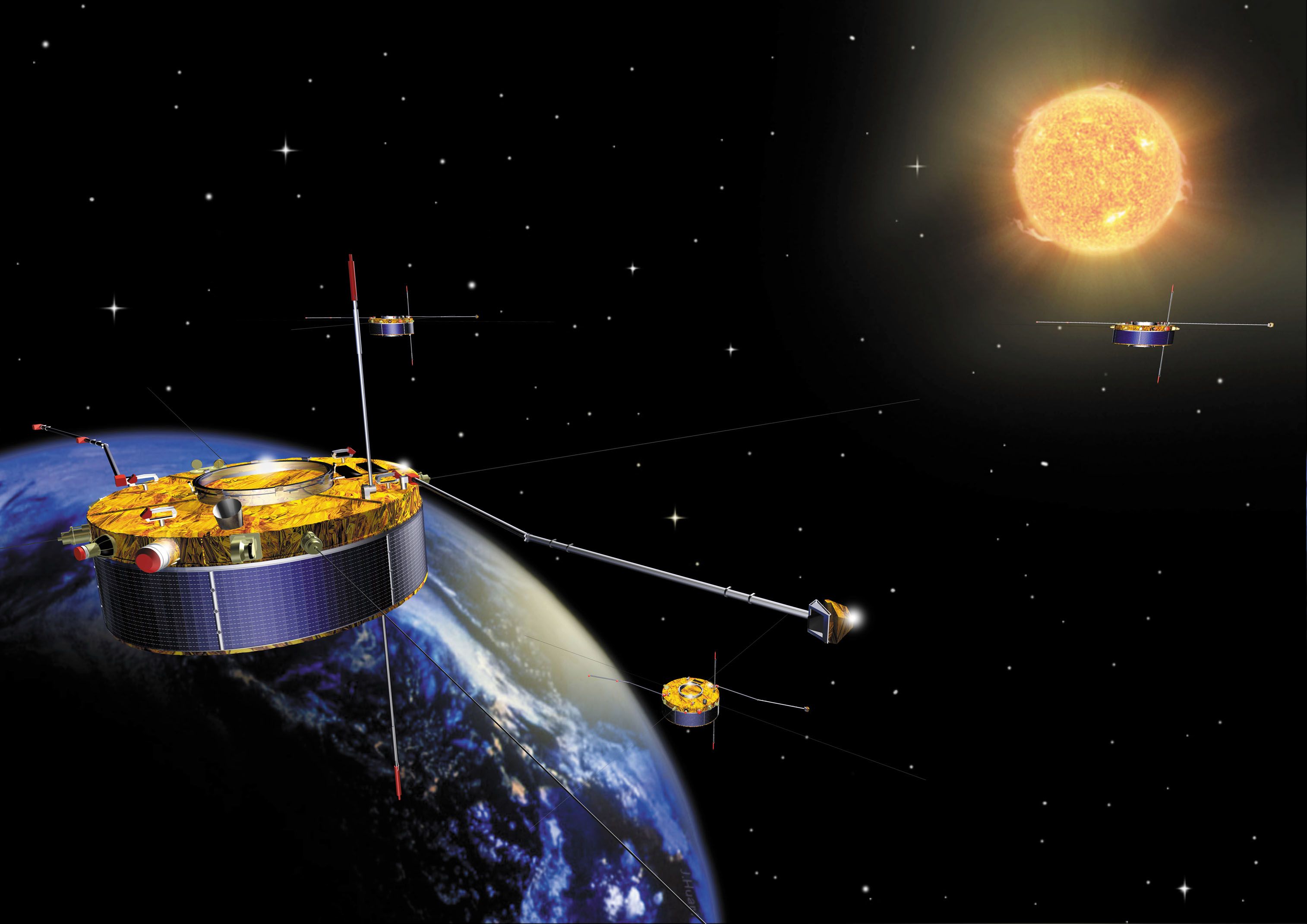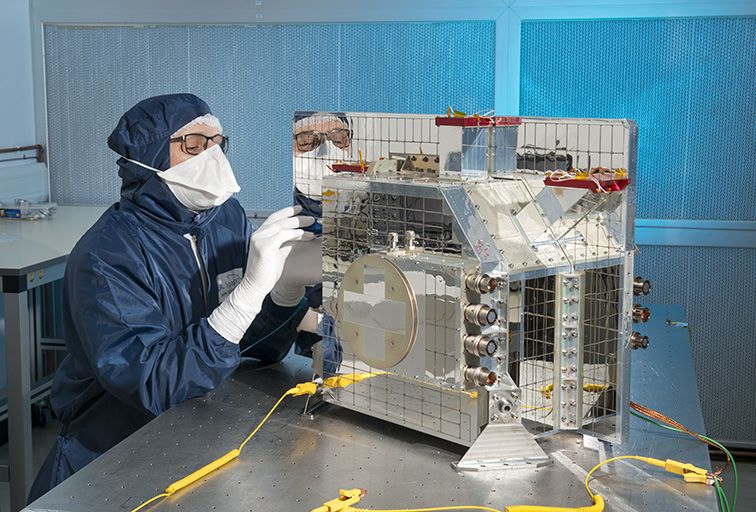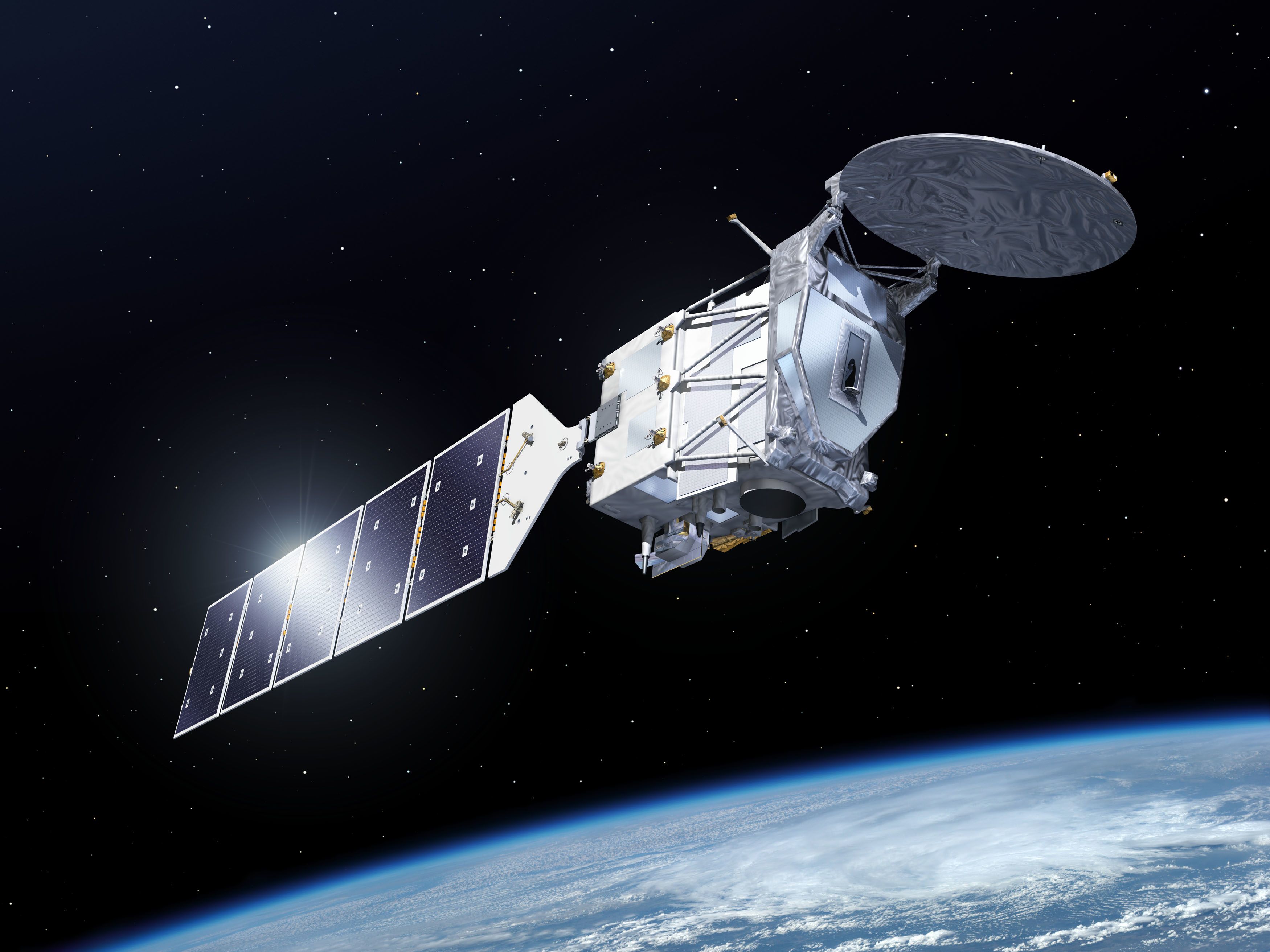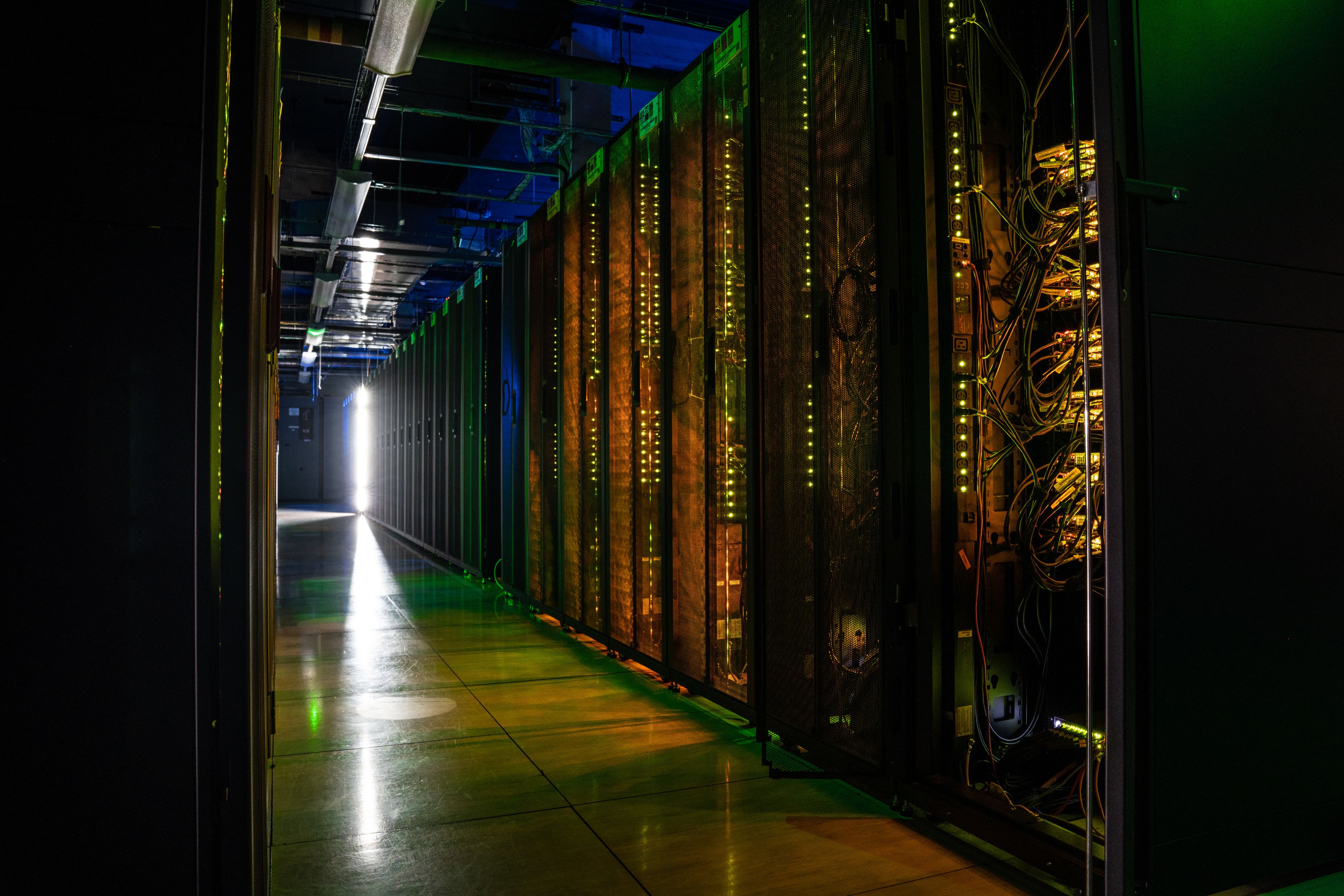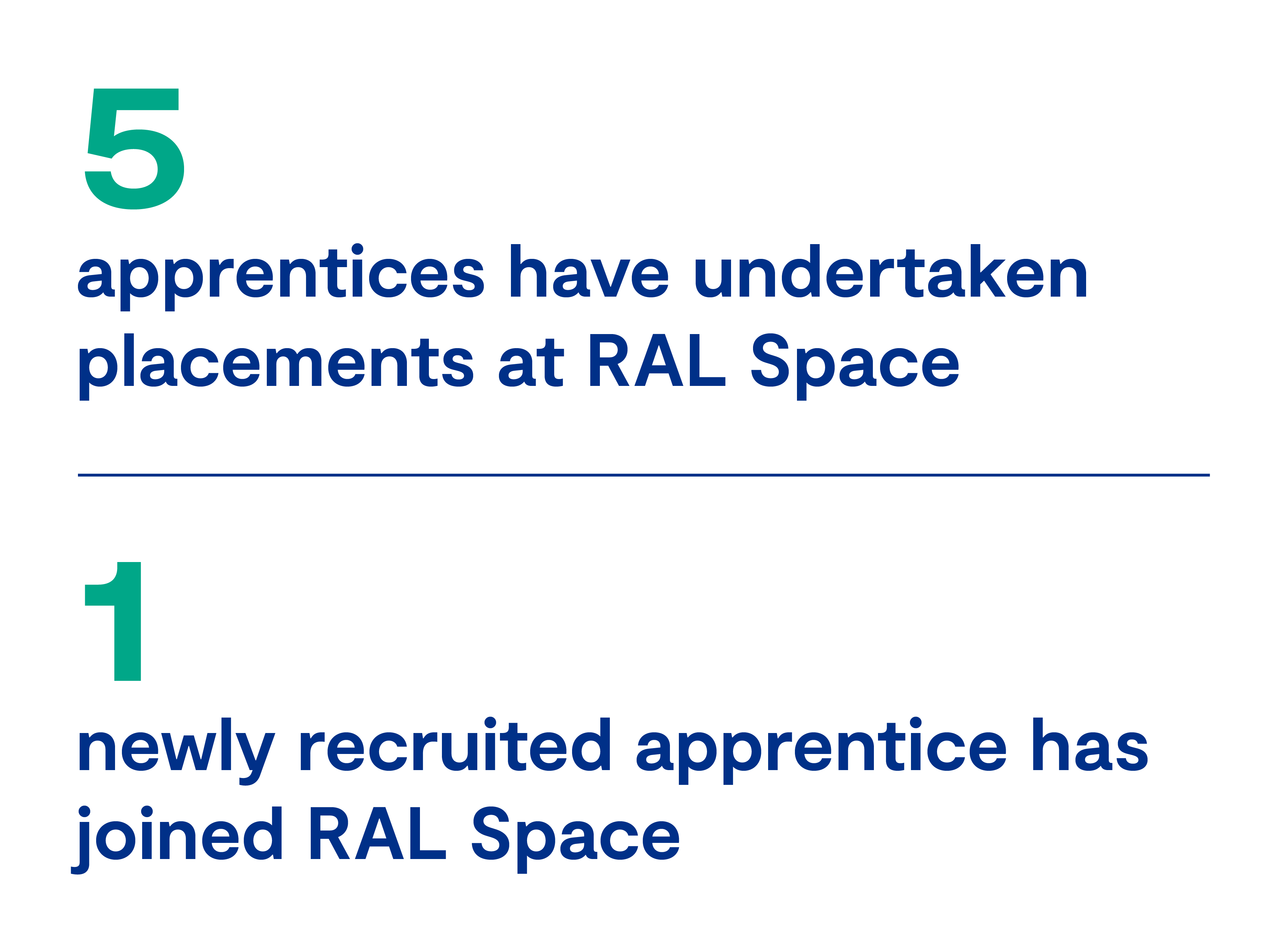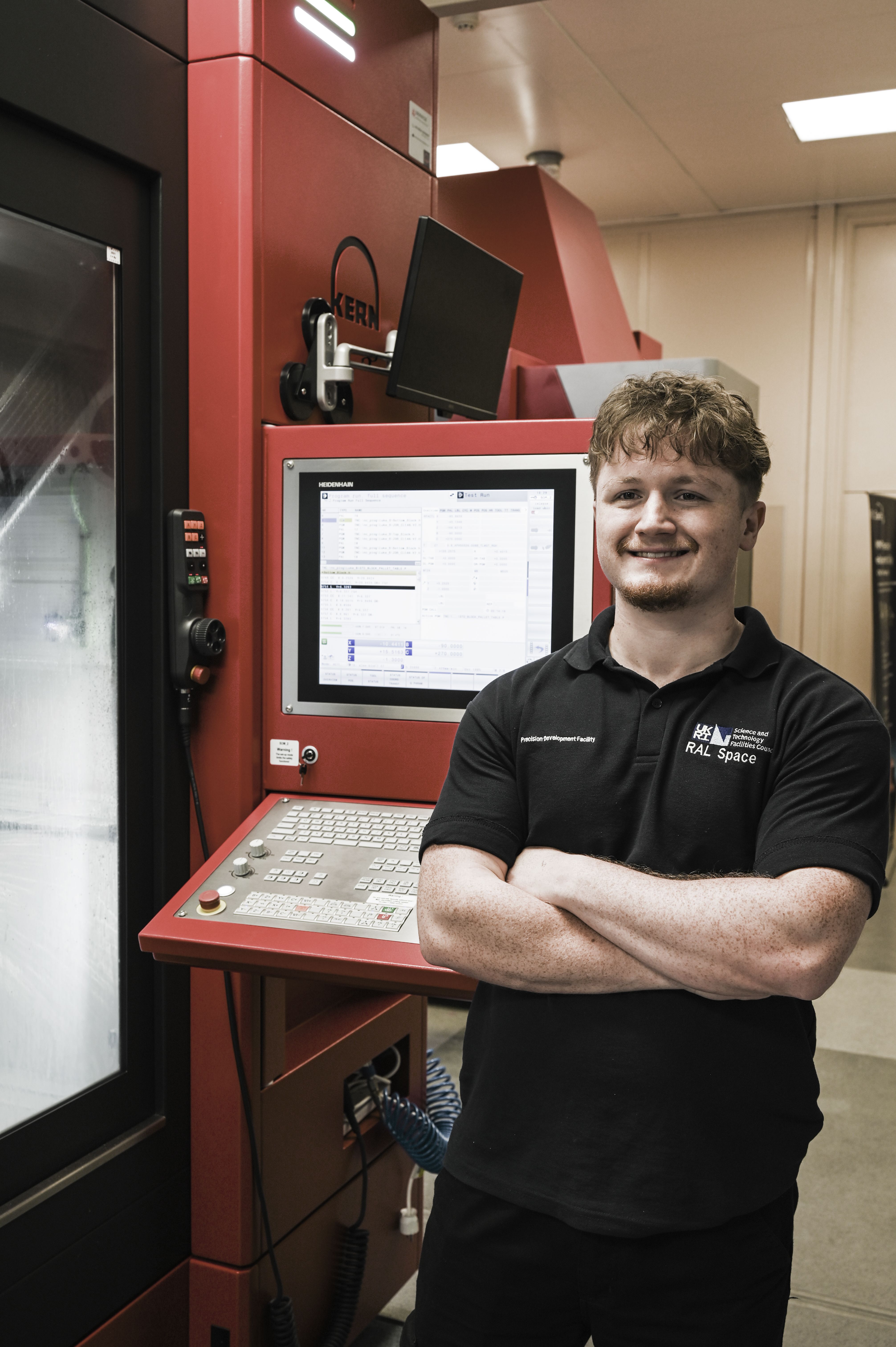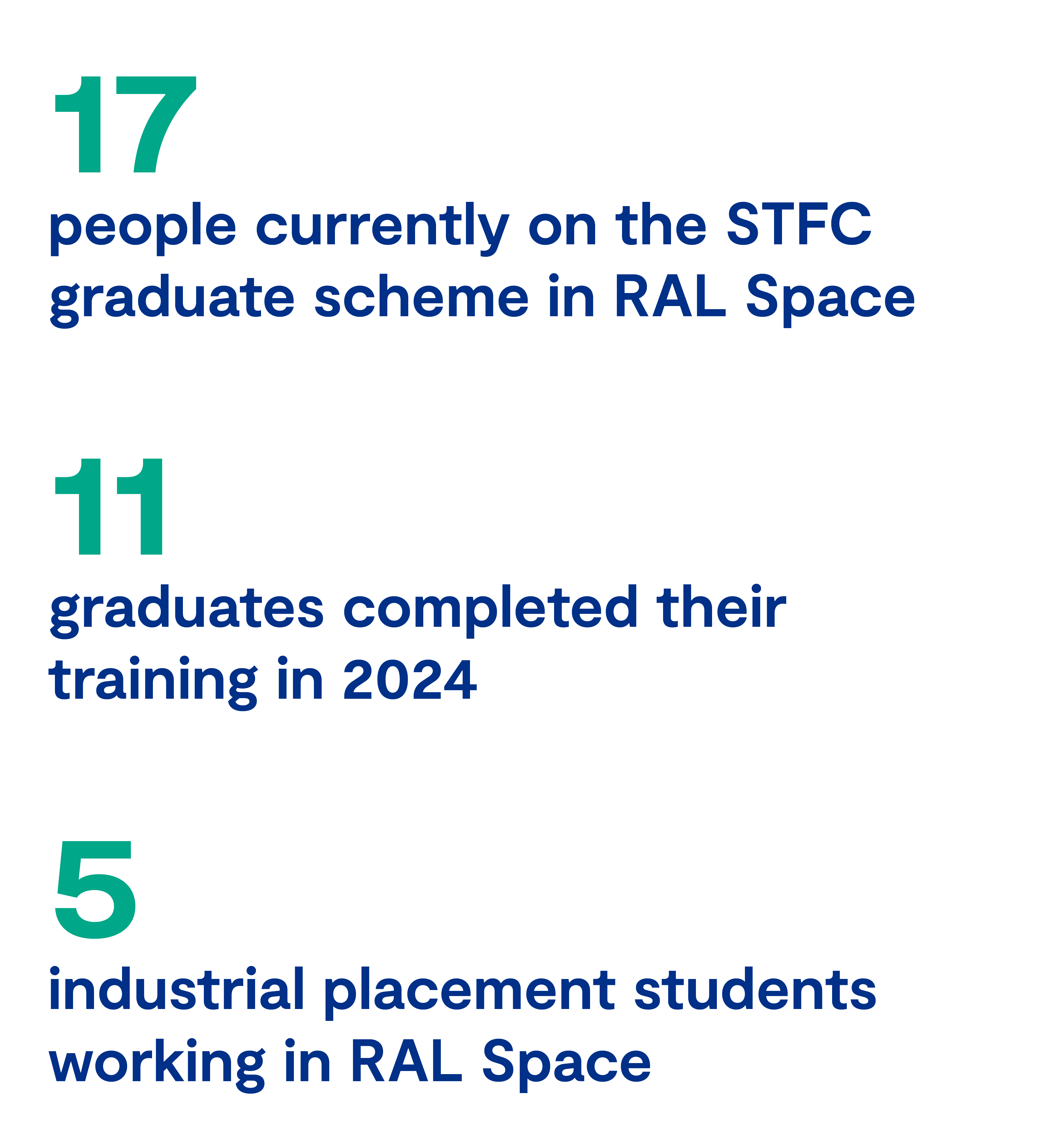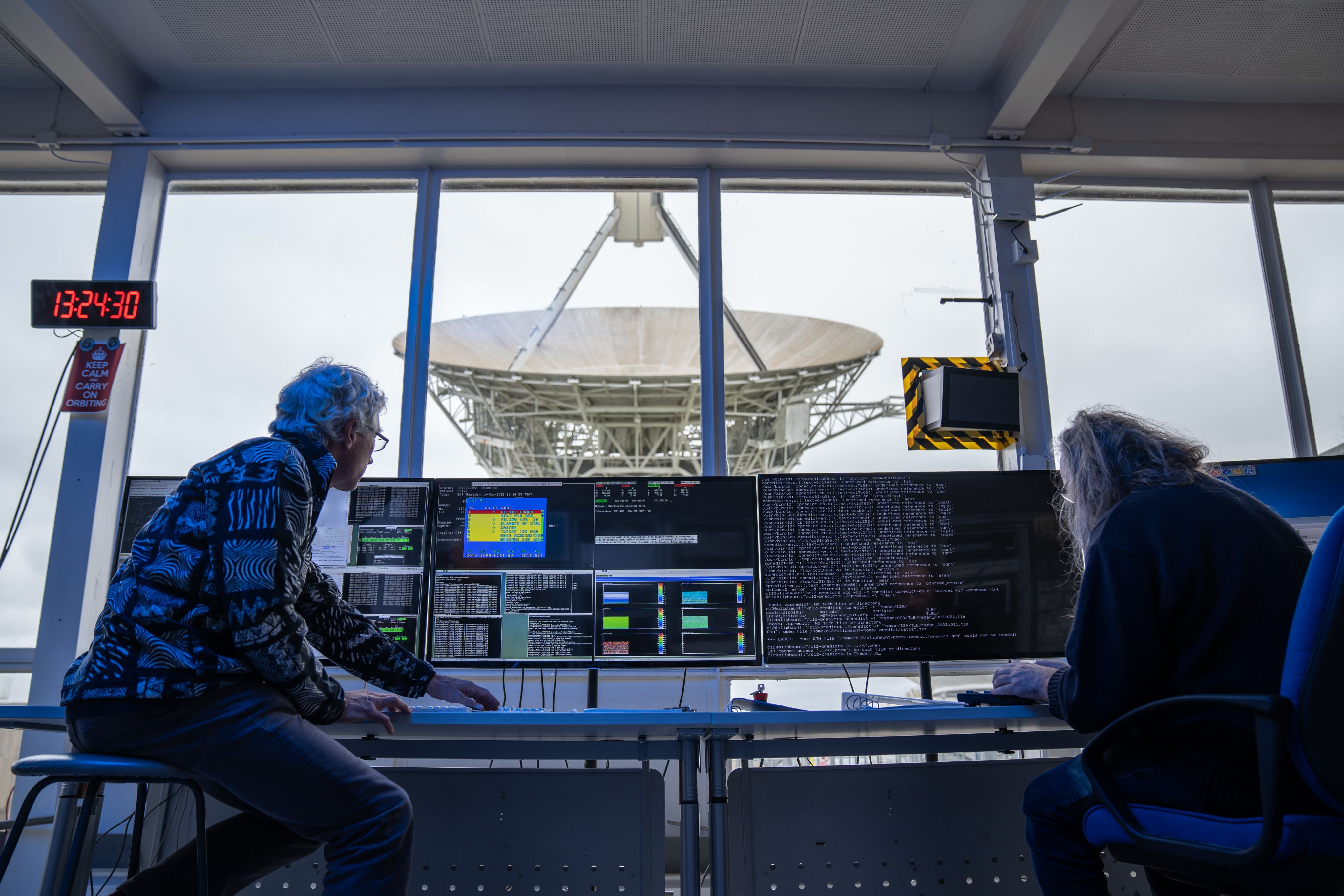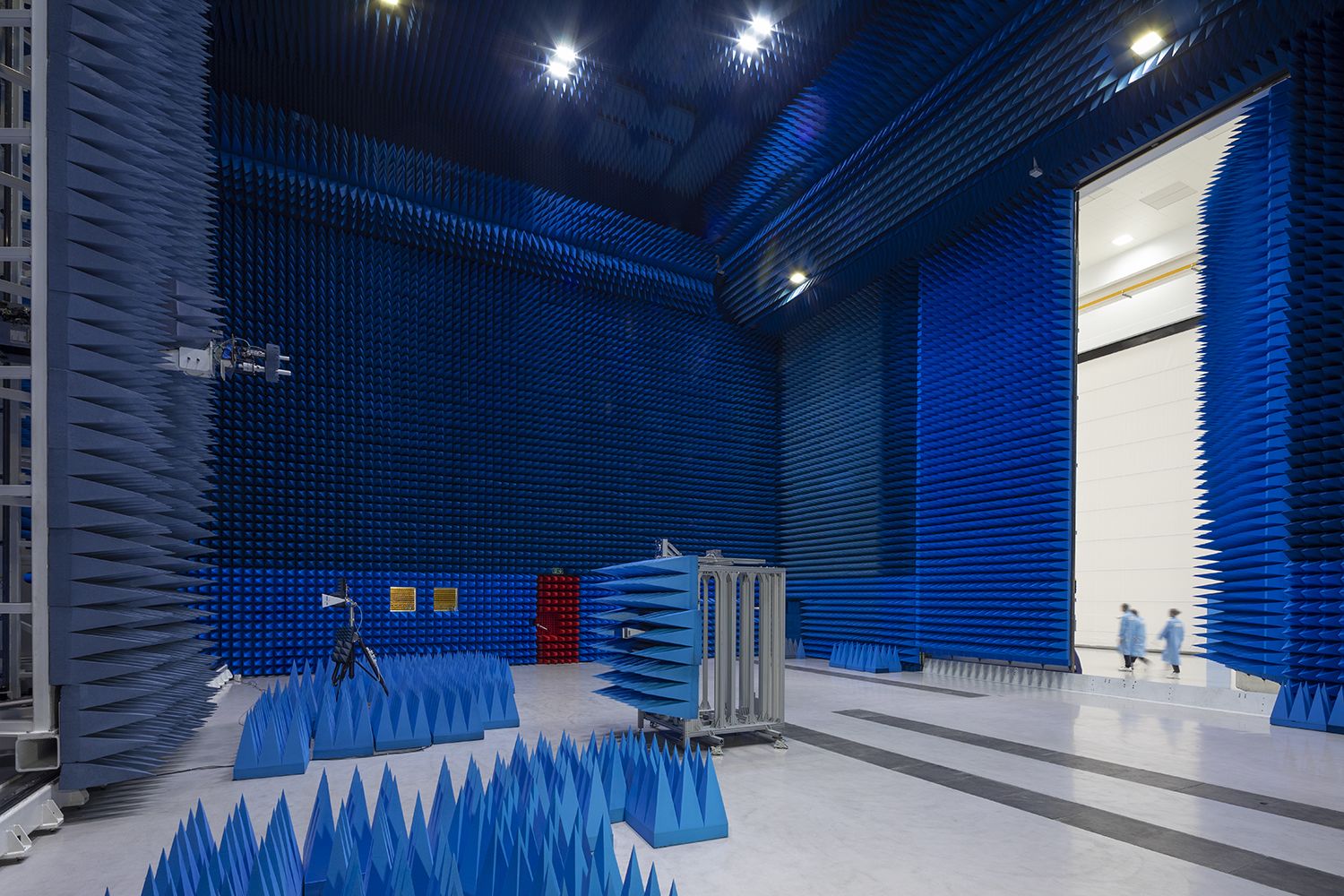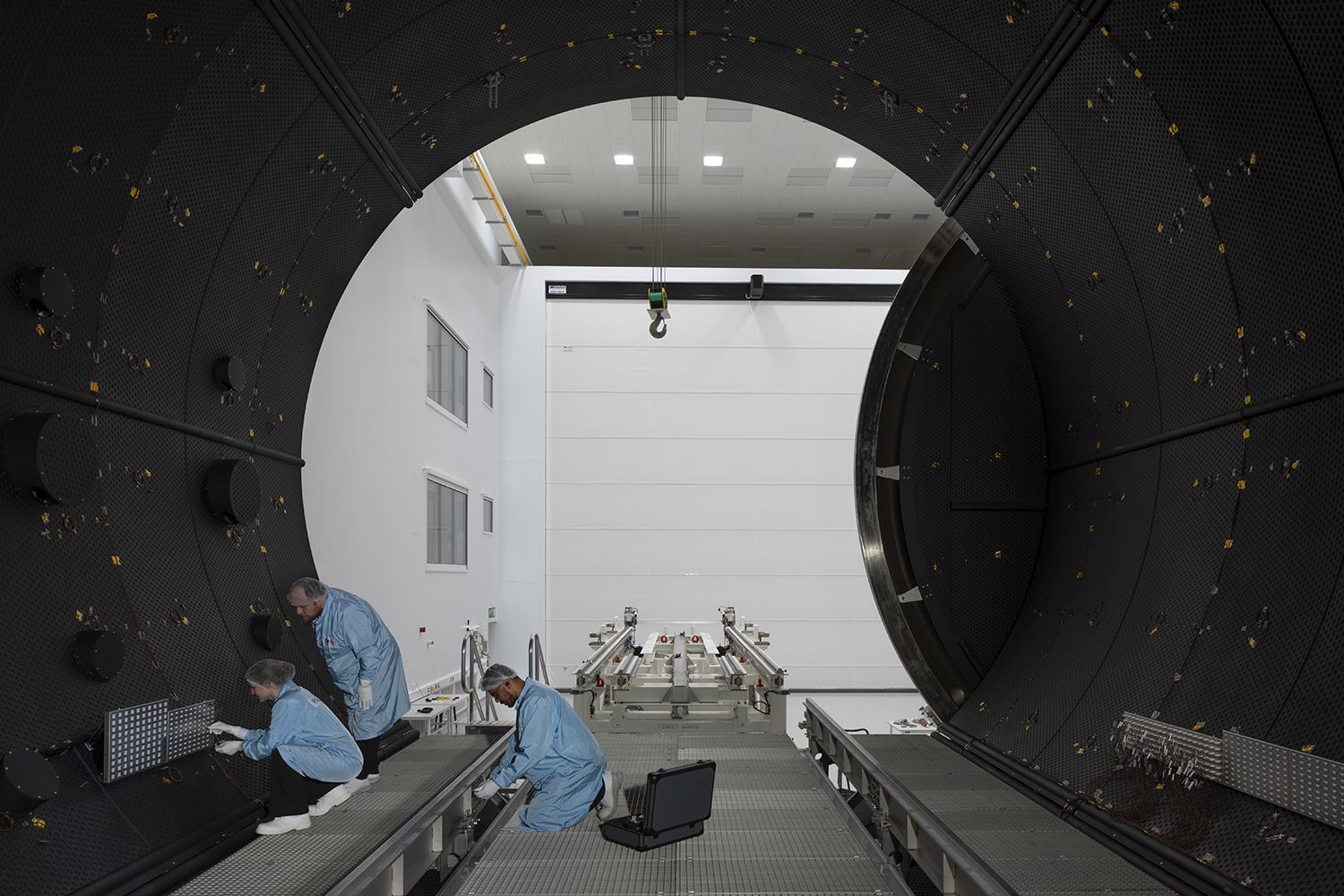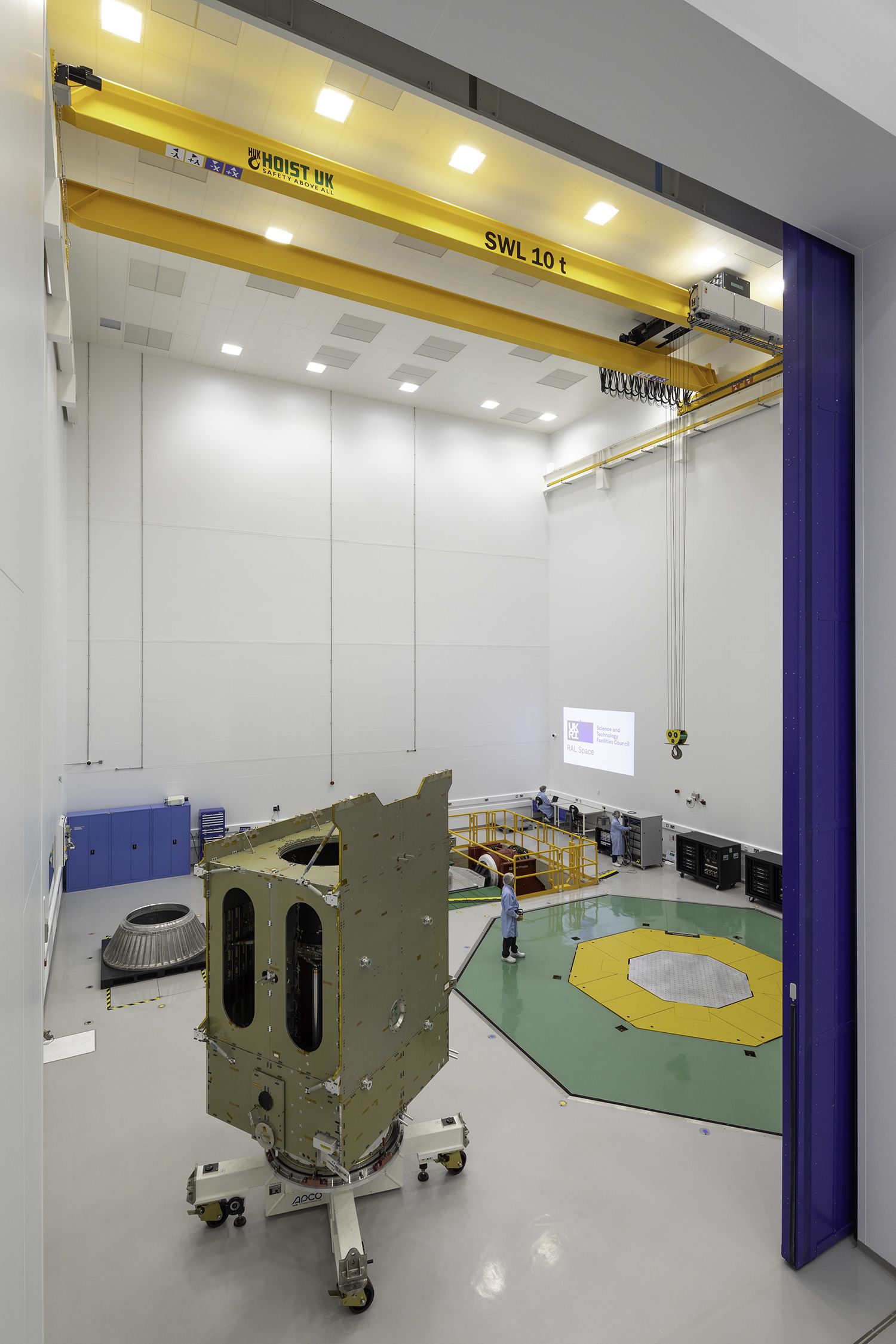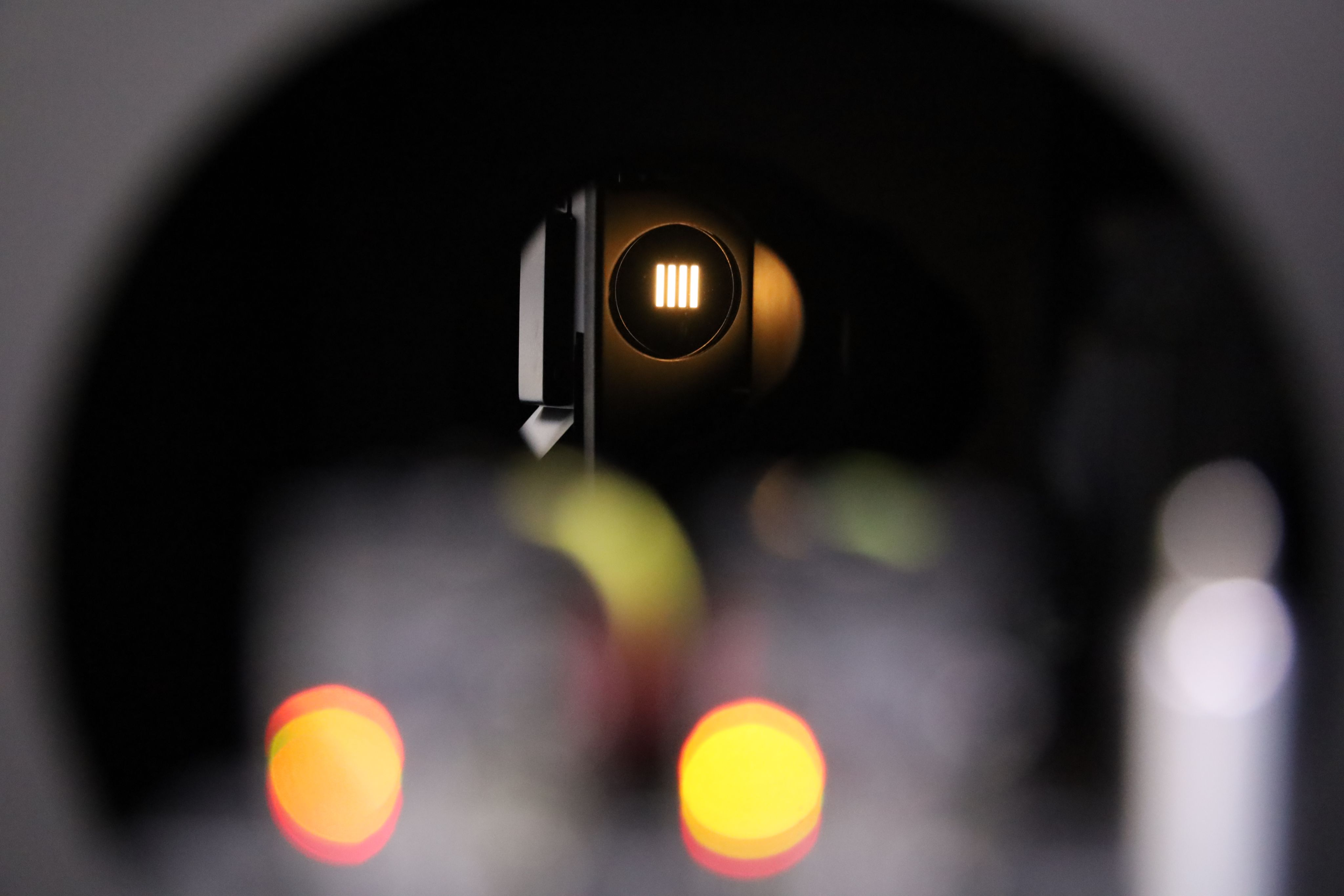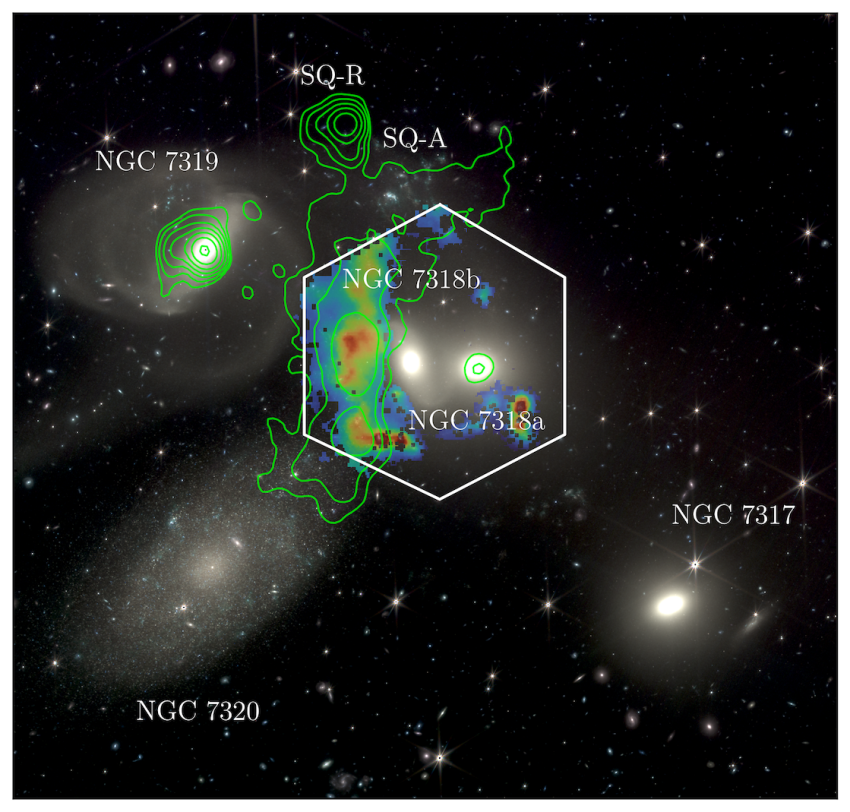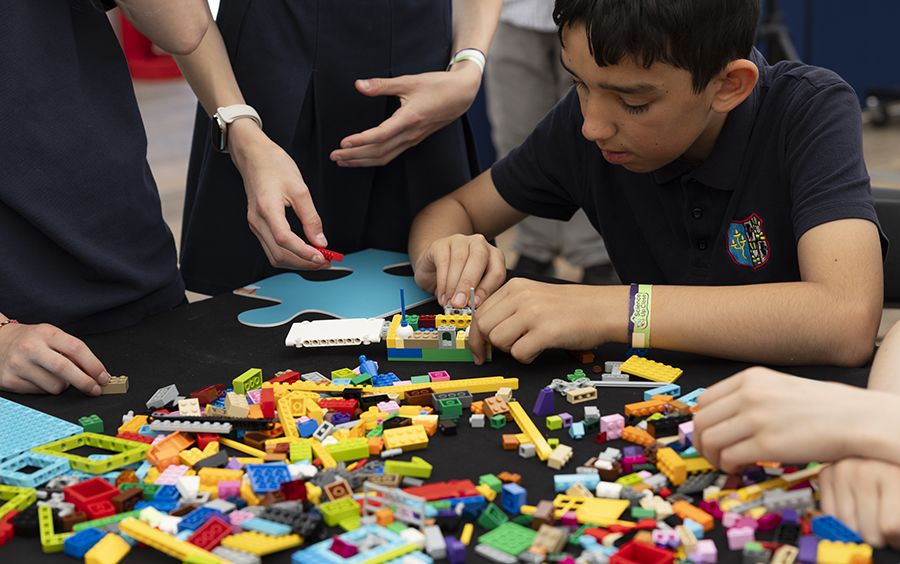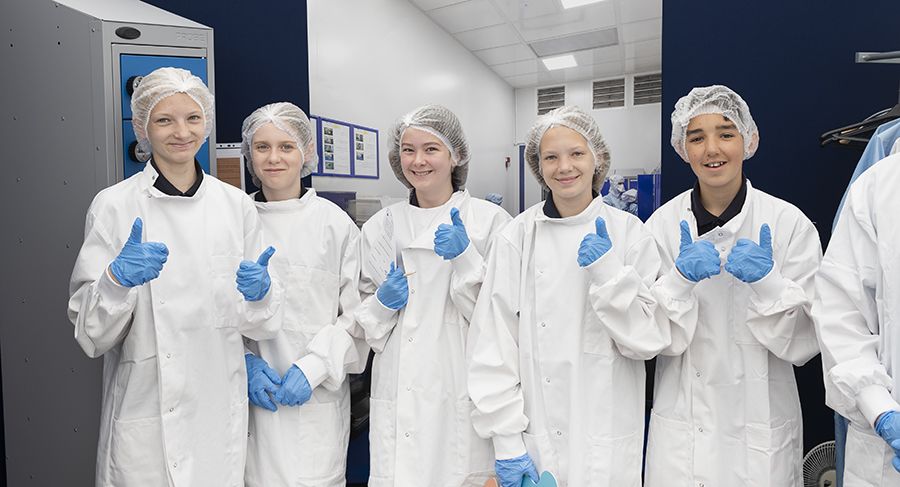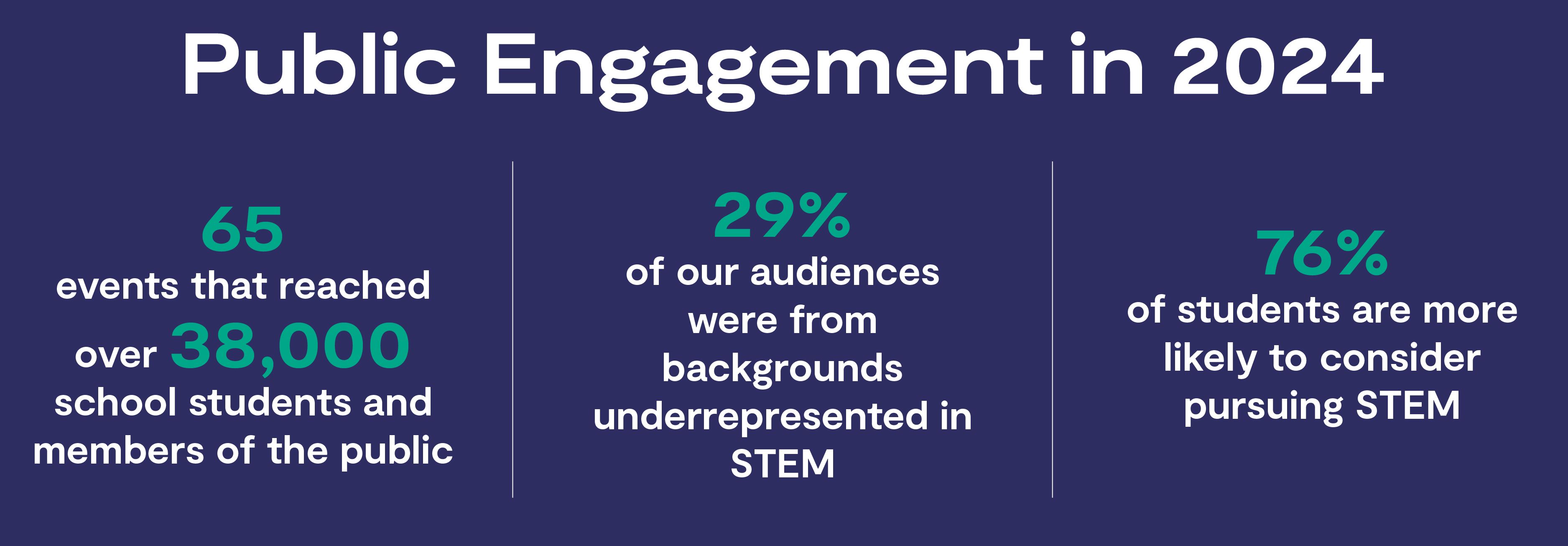Highlights 2024
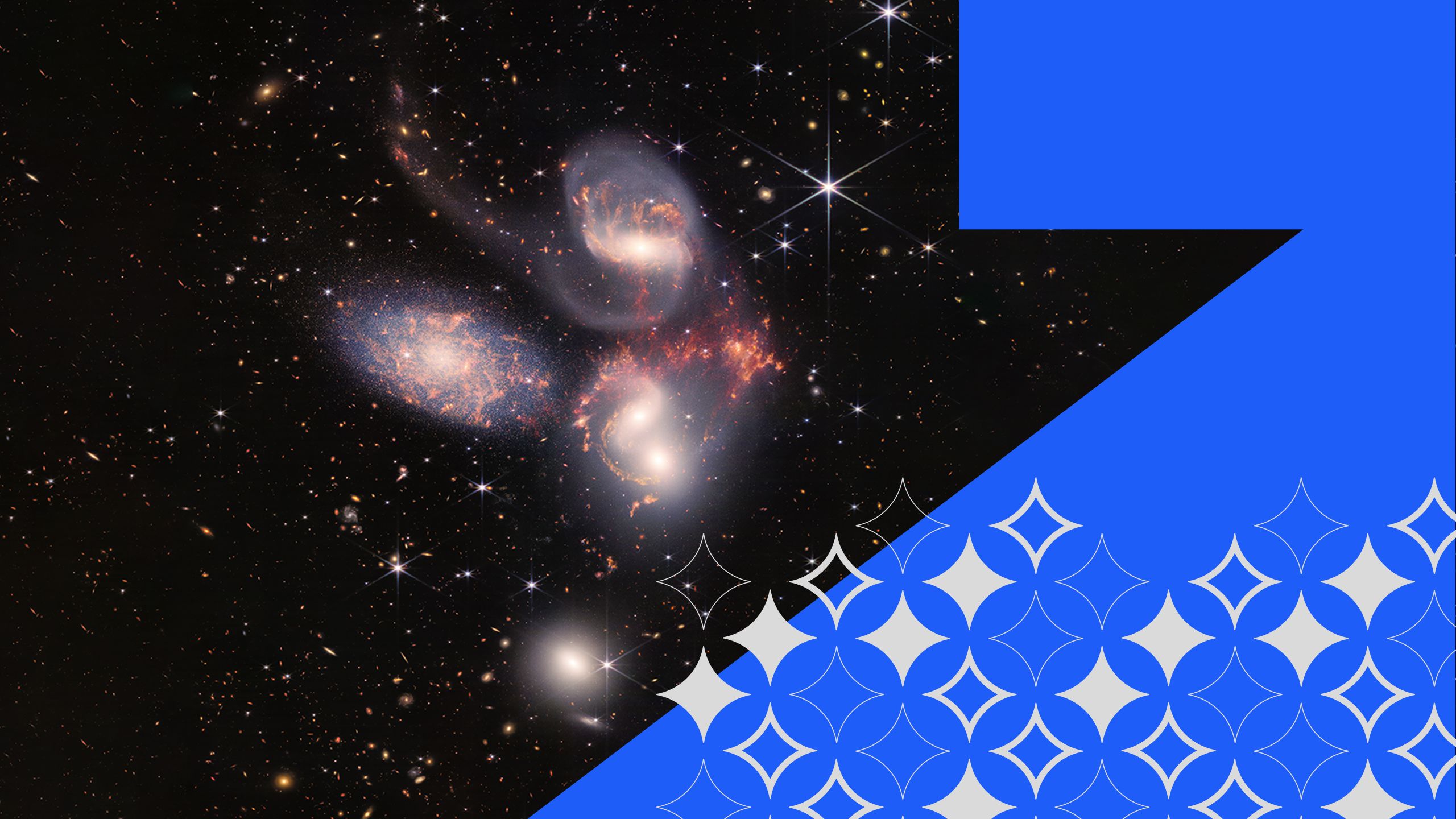
Welcome from
Dr Sarah Beardsley

It is always a proud moment to look back over the year and celebrate the achievements of the incredible people we work with and alongside. I am delighted to share some of these highlights with you here.
Through fundamental research and innovation, we work hand-in-hand with industry, academia and government as a trusted partner, working to deliver the National Space Strategy. Whether we’re enabling access to Earth observation data with our partners at NERC, supporting the development of key national capabilities, or collaborating to facilitate world-class astronomy, RAL Space teams are at the heart of the UK space community.
This year, we were exceptionally proud to welcome our first customers to the National Satellite Test Facility. This remarkable national resource offers large-scale space test facilities under one roof in the UK for the first time, allowing manufacturers of larger spacecraft to test efficiently and effectively.
From large satellites to CubeSats, we are always looking to expand our value to the community. We are thrilled to be co-leading the development of the Small Satellite Calibration Facility at Harwell, an initiative that will provide start-ups and SMEs with access to world-leading calibration services and expertise at a fraction of the cost.
RAL Space is also helping to ensure the sector’s sustainability through our surveillance and monitoring activities. This year, the team at Chilbolton Observatory began providing essential observations to the recently launched National Space Operations Centre, helping to safeguard national space assets.
Dr Sarah Beardsley, Director STFC RAL Space.
Dr Sarah Beardsley, Director STFC RAL Space.
Public engagement remains a key part of what we do, and we were delighted to be part of Harwell Open Week earlier this year. For the first time in nearly a decade, Harwell Campus opened its doors to over 10,000 members of the public, with RAL Space welcoming visitors in droves. Our commitment to inspiring the next generation was also recognised through a prestigious “Corporate Team of the Year” award from the marvellous Jon Egging Trust, with whom we have a long-standing partnership – a personal highlight for me.
As always, I am immensely proud to celebrate these highlights and the achievements of our outstanding teams at RAL Space throughout 2024. Please read on to discover the innovative thinkers behind these achievements, and how our work can support you.
RAL Space - Science driven, technology enabled
As the UK’s national space laboratory, we make our world a better place by partnering with our community to advance knowledge and the use of space and the environment to benefit all.
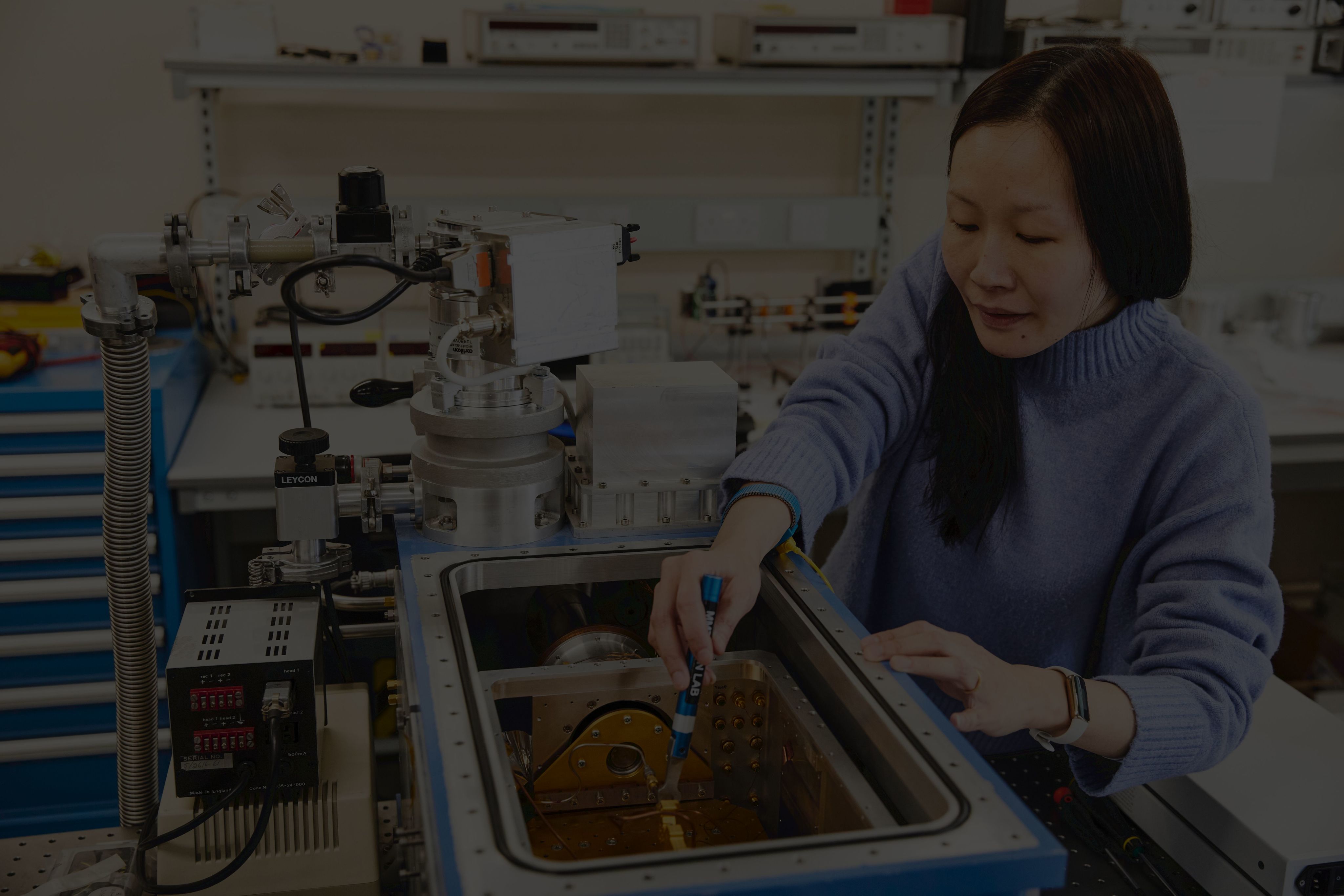
For over 60 years, our state-of-the-art facilities and activities have been at the heart of pioneering scientific research, spanning fields such as Earth observation, space weather, and astronomy. Our mission is to harness our expertise to solve future societal issues, drive economic growth and strengthen our understanding of our place in the Universe. We do this by ensuring the UK leads the world in space-enabled science, data and enabling technologies to develop, deliver and support cutting-edge scientific missions through:
Supporting community access to advanced instruments and unique facilities, rich data archives, services and expertise
Nurturing creative talent, inspiring
scientific, technical and engineering research excellence
Providing exceptional underpinning capabilities that enable advanced solutions and scientific creativity with real-world quantifiable impact
RAL Space is an integral part of the Science and Technology Facilities Council (STFC), part of UK Research & Innovation (UKRI).
Salsa’s last dance: Celebrating 24 years of Cluster operations
After 24 years in space, the first satellite in ESA’s Cluster quartet returned to Earth in a world-first “targeted re-entry” in September 2024, marking the end of a mission that transformed our understanding of the processes behind space weather.
Artist’s impression of the four Cluster II spacecraft in space. Credit: ESA – J. Huart
Artist’s impression of the four Cluster II spacecraft in space. Credit: ESA – J. Huart
Four years after the original Cluster satellites were lost shortly after launch, the four Cluster II satellites embarked on their mission, launching successfully in July and August 2000. On 8 September 2024, well beyond the mission’s expected lifetime of two years, the first of these pioneering spacecraft re-entered Earth’s atmosphere over the South Pacific Ocean.
For over 24 years, Cluster II has helped scientists explore the mysteries of Earth’s powerful magnetic shield, the magnetosphere. This protective bubble shields Earth from the solar wind, a stream of charged particles from the Sun which produce space weather phenomena including the auroras. Though often harmless, severe space weather events can impact satellites as well as communication and power systems on Earth, making the study of these processes vital.
Over its long lifetime, the mission has played a pivotal role in bettering understanding of space weather trends and processes, leading to the publication of over 3600 scientific papers.
Salsa’s last dance: Cluster operations team prepares for satellite re-entry (1 minute 40 seconds)
A grand finale for Cluster’s award-winning operations team
Throughout Cluster’s life in space, commands for the four satellites and their science instruments have been meticulously planned and prepared by an award-winning team based at RAL Space: The Joint Science Operations Centre (JSOC). This is one of only a few examples where this critical responsibility has been contracted to a group outside of ESA.
Week in, week out, JSOC has worked closely with Cluster’s science principal investigators and the spacecraft operations team at ESA’s European Space Operations Centre (ESOC) in Germany to generate the operation plan and translate it into the set of commands to be uplinked to the spacecraft.
The JSOC team’s hard work and dedication has been recognised across the Cluster community, winning awards including a Teamwork Excellence award from ESA in 2014 and The Royal Astronomical Society’s Geophysics Group Achievement Award in 2019. More recently, the UK Cluster Mission Team won the 2024 Sir Arthur Clarke Award for Space Achievement by an Academic Team.
“It’s bittersweet to see the beginning of the end for Cluster. Many of us at JSOC have spent decades working on the project, so it’s been a big part of our lives for a long time. It hasn’t been without its challenges – running continuous operations around spacecraft manoeuvres, eclipses of the solar arrays by the Earth, the batteries dying, and millennium-type bugs when the numbers of orbits and weeks of operations exceeded three figures! – but we can certainly be proud of our contributions to this fantastic mission.”
– Anne Chadwick, Operations Manager at RAL Space’s JSOC.
EarthCARE: Exploring the climate impact of clouds and aerosols
EarthCARE’s Broadband Radiometer undergoing inspections at RAL Space.
EarthCARE’s Broadband Radiometer undergoing inspections at RAL Space.
The challenge
Earth’s energy balance is the process by which our planet absorbs solar energy and radiates heat back into space. This balance is vital for maintaining a stable climate, yet it’s influenced by factors including clouds and aerosols – tiny particles such as dust and pollutants suspended in the atmosphere.
It is already known that clouds and aerosols generally help cool our atmosphere, but their interactions with incoming and outgoing heat
are highly complex, and not fully understood.
As global temperatures soar, understanding these interactions is essential for monitoring our planet and the fight against climate change.
The solution
Enter EarthCARE, a groundbreaking mission jointly developed by the European Space Agency (ESA) and the Japanese Aerospace Exploration Agency, JAXA. This satellite is equipped with four sophisticated instruments, each designed to unravel the complex interactions between clouds, aerosols, and radiation in our atmosphere.
Among them, the Broadband Radiometer (BBR) stands out with its unique capability to observe the atmosphere from three simultaneous directions. Its trio of telescopes captures data from directly downward as well as forward and backward along the satellite’s path. This multi-angle perspective is key to measuring the solar radiation reflected by Earth and the heat emitted from its surface, offering a comprehensive view of our planet’s energy exchange.
RAL Space designed and built this intricate telescope assembly and contributed to the instrument’s thermal design, drawing on extensive expertise from developing previous weather forecasting and climate science instruments.
EarthCARE: exploring the impact of clouds and aerosols on our climate (1 minute 44 seconds)
The outcome
Most of the environmental testing and calibration for BBR took place at RAL Space facilities, with Thales Alenia Space in the UK (TAS UK) leading the instrument’s overall development and test campaign. Following close collaboration between RAL Space and TAS UK, BBR was successfully delivered for spacecraft integration in 2018.
Launched in May 2024, EarthCARE is already delivering remarkable data, with the first images from all four instruments confirming its performance.
Each instrument plays a pivotal role, and measurements from BBR will significantly enhance our understanding of how aerosols, clouds, and radiation interact in our atmosphere. This data will be instrumental in advancing climate science for years to come.
Artist’s impression of EarthCARE in space. Credit: ESA – P. Carril, 2013
Artist’s impression of EarthCARE in space. Credit: ESA – P. Carril, 2013
Revolutionising access to Earth observation data
Staff at the Centre for Environmental Data Analysis (CEDA) are leading a pioneering initiative to facilitate access to Earth observation data for government, business and academia. The Earth Observation Data Hub project aims to enhance decision-making processes across various sectors by integrating high-quality, space-derived data that provides valuable insights.
CEDA is leading the Hub’s project management, overseeing its technical direction and the day-to-day logistics of working with many partners. The team is also leading the procurement of the Hub platform, which will serve as a core system, managing data and services, with a portion of CEDA’s archive being integrated into it. Additionally, three separate applications will be built on top of this platform, each designed to facilitate different types of access, analysis, and interaction.
The EO Data Hub is a two-year project, ending in 2025, aiming to provide a single point of access to the best UK Earth observation data to be utilised by researchers, government bodies, and businesses. The platform is being developed with input from business, academia, and government sectors to ensure it meets a wide range of needs.
Target users and benefits
Government and public sector
The EO Data Hub serves as a centralised platform allowing different government departments to share EO data cost-effectively. This shared access ensures consistency in policy creation, adoption, and monitoring, which in turn supports citizen protection. By providing collective purchasing power, the platform helps reduce costs and enhances the efficiency of governmental operations.
Academia
For the academic community, the Hub offers collaboration opportunities and access to extensive time-series data, which is critical for scientific research. The Hub provides advanced workflows that allow researchers to focus more on scientific exploration and analysis, contributing to the generation of trustworthy data.
Industry
Businesses benefit from the EO Data Hub by gaining insights into environmental risks, both local and global. Access to authoritative data is crucial for businesses to make informed decisions regarding investment planning, due diligence, and regulatory compliance. The platform will support businesses in understanding the implications of environmental changes on their operations.
Funding and Partners
The EO Data Hub is funded approximately £10 million by NERC through the Earth Observation Investment Package provided by the Department for Science, Innovation and Technology.
The consortium is led by the National Centre for Earth Observation including staff from CEDA and the University of Leicester, and public-funded partners in the Satellite Applications Catapult, the UK Met Office, and the National Physical Laboratory.
It also has industrial partners delivering the project software and data infrastructure.
The JASMIN data intensive supercomputer hosts the CEDA Archive. Credit: National Centre for Atmospheric Science
The JASMIN data intensive supercomputer hosts the CEDA Archive. Credit: National Centre for Atmospheric Science
Meet our team

Apprentices

Meet Lucas Ward, CNC Machinist
What does your role involve?
I make things that go up into space! More specifically, I work in a specialised manufacturing facility that underpins remote sensing and atmospheric science instrumentation. I programme and run Computer Numerical Control (CNC) machines to build intricate components used in Earth observation and ground-based astronomy.
How did you get into this role?
I was originally planning to go to sixth form then university, but my school didn’t offer a higher education engineering opportunity which is what I was most interested in. With the help of the school’s careers board, I discovered and applied to STFC’s Advanced Manufacturing Engineering apprenticeship at the Rutherford Appleton Laboratory.
This involved technician work, assembly work, design work, and both manual and CNC machining. It was a great way to get a taste of everything and find out what I enjoyed most. After four years, I accepted a position in RAL Space’s Precision Development Facility.
What do you like most about your job?
The fact that some of the things I make end up in space – how cool is that? It’s fascinating to think that something I have machined is way up there in orbit.
I also love supporting science that really matters. A lot of our instruments are for satellites providing real-time data for weather prediction and climate modelling. It feels good to be part of the solution in collecting such important information about our planet.
What skills do you use most?
Being a CNC programmer and machinist requires a mix of skills, but problem solving is probably number one. It is never as simple as just pressing a button! You need to be able to think on your feet and come up with solutions quickly.
Of course, you need technical skills too – programming, understanding materials, operating the machines, but those are all learnable. It’s the problem-solving, determination and on-the-job experience that really make the difference.
Lucas Ward with CNC machines
Lucas Ward with CNC machines
What advice would you give to your younger self?
Seize the moment and don’t procrastinate! When work comes along, do it when you first get the chance. It will feel so much better to get it done and out of the way. Then you can enjoy whatever it is you wanted to do afterwards without any guilt or stress. It’s easy to delay and leave things to later, but getting on top of things early makes life so much easier. And who knows – it might even lead you to an awesome apprenticeship opportunity!
Graduates

Meet Dr Elin McCormack (1 minute 37 seconds)
Supporting UK space domain awareness
The challenge
Since the dawn of the Space Age in 1957, over 6,700 successful rocket launches have placed over 19,500 satellites into Earth’s orbit. Today, around 10,000 of these remain in orbit, a fraction of the estimated 40,000 objects larger than 10cm currently in low-Earth orbit.
Monitoring these objects in space for collision risks and re-entries is essential to protect assets in space and on the ground.
The solution
Launched in May 2024, the National Space Operations Centre (NSpOC) brings together advanced space domain awareness capabilities to enable operations and protect UK interests in space and on Earth.
NSpOC uses a global network of sensors and data streams, overseen by a team of co-located civil and military analysts to deliver critical missions in support of UK and allied space objectives including:
- re-entry early warning
- in-space collision avoidance
- fragmentation alerting
- support to license monitoring
- planetary defence against asteroids and meteorites
- space weather notifications via the Met Office
The RAL Space team at Chilbolton Observatory provides high-precision radar and optical observations directly to NSpOC, enabling real-time tracking of satellite movements and supporting NSpOC’s mission to safeguard national space assets.
Inside the control room at Chilbolton Observatory. Credit: National Centre for Atmospheric Science
Inside the control room at Chilbolton Observatory. Credit: National Centre for Atmospheric Science
The outcome
With Chilbolton Observatory’s support, NSpOC operates around the clock, issuing on average 2,200 collision warnings to satellite providers each month.
By delivering high-resolution tracking of satellites and debris, with more precise characterisation capabilities under development, Chilbolton Observatory plays a critical role in NSpOC’s capacity to maintain space domain awareness and secure UK space interests.
NSpOC is led by the UK Space Agency and UK Space Command in partnership with the Met Office.
"As the UK’s economy becomes increasingly reliant on space, the Chilbolton Observatory has played a vital role in enabling the NSpOC to detect and respond to space activities through its radar and optical tracking capabilities."
– Andy Hammett, Deputy Head, National Space Operations Centre (NSpOC)
Lift off for the National Satellite Test Facility
In 2024, the UK’s first “one stop shop” for large satellite testing opened its doors and welcomed its first customers.
Electromagnetic compatibility and antenna testing facilities.
Electromagnetic compatibility and antenna testing facilities.
The result of a 2015 Facilities Gap Study from the UK Space Agency, the National Satellite Test Facility (NSTF) is designed to ensure that spacecraft up to 7 tonnes will survive launch and the harsh conditions of space. Mini-bus sized satellites will be shaken violently to simulate rocket launch conditions, and baked in the UK’s largest space test chamber to test their resilience to the extreme temperatures they will face in Earth’s orbit and further afield.
For the first time, the UK has a comprehensive set of large scale space test facilities all under one roof. This includes a dynamics suite, where satellites will be shaken and exposed to levels of sound replicating that of a rocket launch, and a 7m-diameter space test chamber to simulate the vacuum and temperature conditions of space. The NSTF also features an impressive electromagnetic compatibility and antenna test chamber where satellites’ communications systems can be tested securely.
RAL Space has decades of experience operating similar tests in existing facilities, which include a range of vacuum chambers up to 5m in diameter and a smaller-scale vibration facility. However, the NSTF has extended these capabilities as well as our team of experts, having already led directly to 30 new jobs in the Oxfordshire area including several apprenticeship and graduate opportunities.
The NSTF's large space test chamber.
The NSTF's large space test chamber.
Inside the dynamics testing suite.
Inside the dynamics testing suite.
Introducing RAL Space's National Satellite Test Facility (3 minutes 56 seconds)
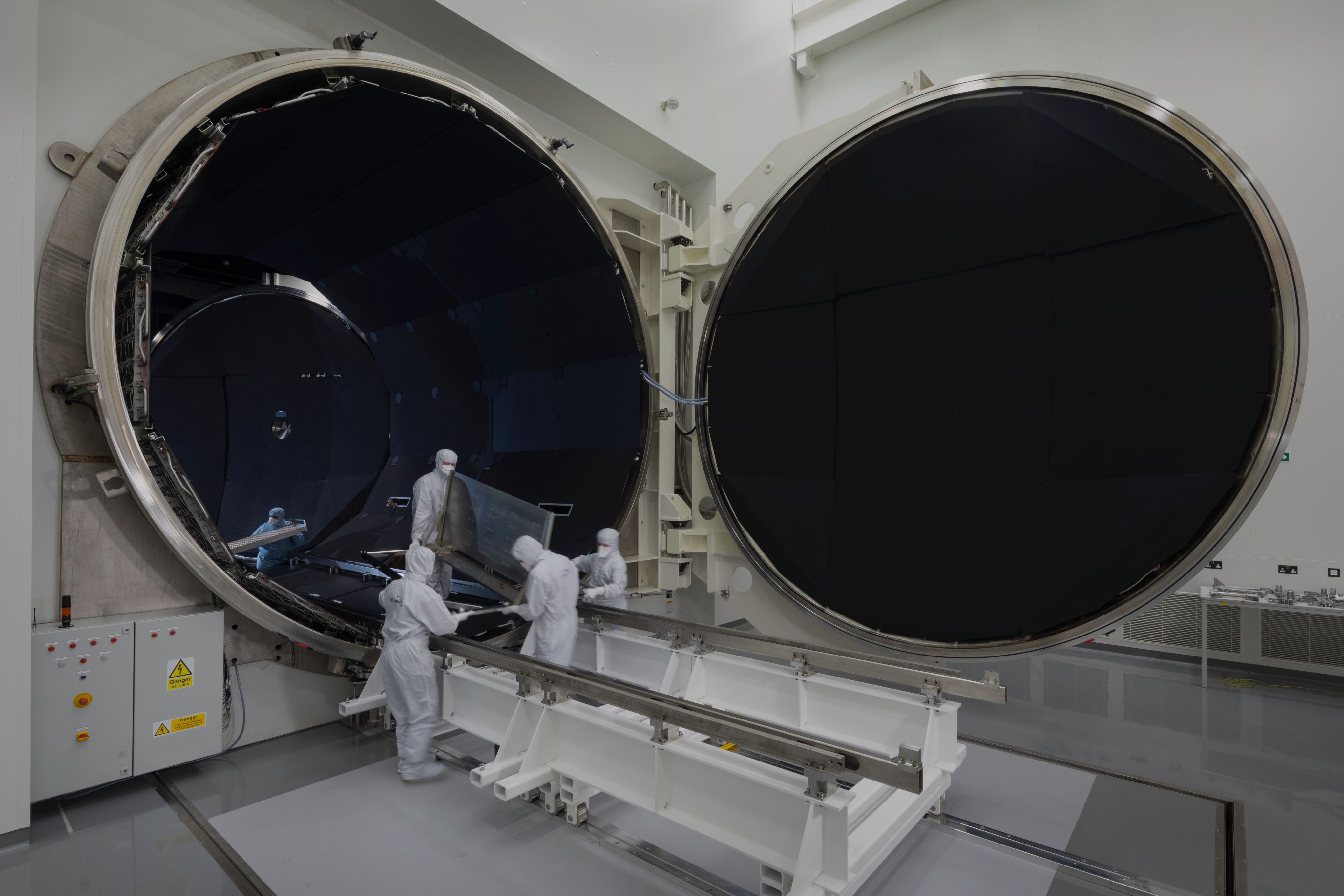
New facility set to boost UK EO sector
The challenge
In the era of ‘new space’, a growing number of start-ups and SMEs are venturing into the development of small satellite instruments for diverse Earth observation applications. Calibrating sensors for these applications is vital to ensure the accuracy and utility of data collected in orbit.
While large satellite missions and programmes might invest in bespoke calibration solutions, this would present a significant barrier for smaller companies, many of which lack the capacity, budget or expertise to develop their own calibration testing facilities.
The solution
As leaders in establishing cutting-edge facilities for pre-launch testing and calibrating satellite technology, RAL Space and the National Physical Laboratory (NPL) are combining strengths to build a new national centre for testing and calibrating instruments on small, cube, and nano satellites – the Small Satellite Calibration Facility.
Combining expertise and instrumentation from both organisations, the facility will be based at RAL Space on Harwell Campus in Oxfordshire, already a bustling campus of over 100 local and international space organisations.
The outcome
The Small Satellite Calibration Facility, supported by experts from RAL Space and NPL, will empower start-ups and SMEs by providing access to world-leading calibration services at short notice and a fraction of the cost. This initiative not only lowers the barrier to entry for aspiring space companies but also gives them a competitive edge through enhanced data quality and more reliable missions.
Ultimately, this facility will further boost the UK’s thriving Earth observation sector, supporting critical data that helps us monitor and protect our planet.
Close up of instrumentation at the Small Satellite Calibration Facility.
Close up of instrumentation at the Small Satellite Calibration Facility.
"RAL Space is excited to be working with NPL on this new facility, and to hear from small space companies about how we can support to ensure they’re getting the best possible data from their instruments.
Ensuring these instruments are calibrated effectively means we can be confident in the information they send back to us on Earth, helping us make better decisions about our planet."
– Dr Dan Peters, RAL Space Technical Lead for the Small Satellite Calibration Facility
"By working together on the SSCF, RAL Space and NPL combine our complementary expertise. This collaboration allows us to offer world-class calibration services to enhance data quality and mission reliability, lower barriers to entry for new space companies, and strengthen the UK’s position in the Earth observation sector."
– Christopher Baker, NPL Technical Lead for the Small Satellite Calibration Facility
First Science Results from WEAVE
A 2-million-mph galaxy collision has been observed in new detail thanks to WEAVE – a cutting-edge upgrade to the William Herschel Telescope (WHT) led by RAL Space and the University of Oxford.
The nearby galaxy group Stephan’s Quintet has captivated astronomers since its discovery in 1877. Past collisions between galaxies have left behind a complex field of cosmic debris, making it the ideal testbed to study the chaotic and violent interactions between galaxies, and an ideal target for first-light observations from the WHT’s Enhanced Area Velocity Explorer: WEAVE.
In November 2024, WEAVE’s first science results were published. Led by the University of Hertfordshire, the team combined WEAVE data with observations from other powerful instruments including the Low Frequency Array (LOFAR), the Very Large Array and the James Webb Space Telescope. Together, they reveal the previously unknown dual nature of the shock generated by the galaxy NGC 7318b as it slammed into Stephan’s Quintet at over 2 million miles per hour.
As the immense shockwave moves through cold gas in the region, its speed is strong enough to tear electrons from their atoms, leaving behind a glowing trail of charged gas. Yet, when it travels through regions of hot gas, it becomes much weaker and produces radio waves detectable by telescopes like LOFAR.
Led by RAL Space and the University of Oxford,the European consortium behind WEAVE has spent over a decade bringing this instrument to life, enabling its remarkable ability to capture high-resolution images and analyse light from nearly 1,000 celestial objects simultaneously. It offers up to 10 times the precision of other spectrographs, allowing for detailed measurements of chemical elements in distant galaxies.
These first results are just the beginning for WEAVE. Over the next five years, the instrument will conduct a 1,200-night survey, collecting more than 12 million spectra. This wealth of data will help map dark matter in the Milky Way, study galaxy evolution, and explore the fascinating relationships between galaxies and their central black holes.
Weave data overlaid on a James Webb Space Telescope image of Stephan’s Quintet, with green contours showing radio data from the Low Frequency Array radio telescope. Credit: M. Arnaudova/University of Hertfordshire/WEAVE consortium.
Weave data overlaid on a James Webb Space Telescope image of Stephan’s Quintet, with green contours showing radio data from the Low Frequency Array radio telescope. Credit: M. Arnaudova/University of Hertfordshire/WEAVE consortium.
"These first science results from WEAVE represent a huge achievement for the entire consortium. The instrument has been in development for over a decade, so it’s really rewarding to see it being used for remarkable science and fantastic to see the level of detail uncovered here. As well as the details of the shock and the unfolding collision that we see in Stephan’s Quintet, these observations provide a remarkable perspective on what may be happening in the formation and evolution of the barely resolved faint galaxies that we see at the limits of our current capabilities."
– Professor Gavin Dalton, WEAVE Principal Investigator at RAL Space and the University of Oxford
I’m excited to see that the data gathered at the WEAVE first light already provide a high-impact result, and I’m sure this is just an early example of the types of discoveries that will be made possible with WEAVE on the William Herschel Telescope in the coming years.
– Dr. Marc Balcells, Director of the Isaac Newton Group of Telescopes
Ground-based astronomy at RAL Space
2007
The UK-Japan FMOS multi-object infrared fibre spectrograph was integrated at the Japanese 8.3m Subaru telescope in Hawaii.
2009
Science operations began for the European Southern Observatory’s Visible and Infrared Survey Telescope for Astronomy (ESO’s VISTA).
RAL Space led the VISTA camera consortium with the UK Astronomy Technology Centre and Durham University.
2010
Since 2010, RAL Space has hosted LOFAR-UK, part of the Europe-wide Low Frequency ARray (LOFAR) radio telescope, at Chilbolton Observatory.
2012
The K-Band Multi Object Spectrometer (KMOS), a collaboration of six institutions including RAL Space and the UK Astronomy Technology Centre, was integrated onto ESO’s Very Large Telescope.
2013
The ALMA array was officially inaugurated in 2013.
RAL Space previously hosted the European Front End Integration Centre for the Atacama Large Millimeter/Submillimeter Array (ALMA) and supplied around 1000 mixers to ensure coherent operation of ALMA’s sensitive receivers.
2019
Developed by the University of Manchester and RAL Space, the Collaborative Heterodyne Astronomical Receiver for Mexico (CHARM) was delivered to the Large Millimeter Telescope.
2021
Integration of WEAVE began at the William Herschel Telescope.
2023
Developed by RAL Space and partners from the University of Manchester and STFC’s Technology Department, CARUSO was delivered to the Sardinia Radio Telescope.
Looking ahead...
Our teams are working on some of ground-based astronomy’s most exciting up-and-coming projects.
These include developing the science data processor that will eventually process the vast amounts of data from the Square Kilometer Array Observatory, and contributing to the HARMONI and MOSAIC instruments for ESO’s Extremely Large Telescope.
Mission Phoenix – A Lasting Legacy in Public Engagement
It’s been another busy year for RAL Space public engagement, with much of our focus this year revolving around the major Harwell Open Week event.
For the first time in nine years, Harwell Science and Innovation Campus opened its doors to 2,000 school children and over 10,000 members of the public – offering a rare opportunity to experience world-class science and facilities up close.
In addition to welcoming visitors to our laboratories and space test facilities, RAL Space ran Mission Phoenix, an escape-room-style activity for schools and the public.
Set on the fictional Ember Island that faces recurring wildfires, Mission Phoenix challenged teams to complete tasks designed to help bring residents to safety. From suiting up in clean room gear, to using infrared cameras to detect heat sources, and analysing real satellite images, each task brings participants closer to the mission’s goal: preparing a new satellite that will keep a watchful eye over Ember Island to monitor future wildfires.
As teams progressed, they pieced together a map revealing fire locations and data about the harmful smoke, helping them to chart a safe evacuation route for a school on the island.
Mission Phoenix showcased the breadth of work behind real space missions, highlighted the tangible impacts of Earth observation, and allowed visitors to meet and engage with staff from across RAL Space – increasing awareness of a wide range of career opportunities.
RAL Space and partner organisations are now focusing on how to build a lasting legacy from such events. Following its success during Harwell Open Week, Mission Phoenix is a popular staple activity in our public engagement programme as a fun, accessible experience of learning STEM subjects for everyone. We have since welcomed local schools to complete the activity for World Space Week and plan to expand its use and value as an educational tool for teachers and our communities.
For more information, please contact
Rutherford Appleton Laboratory
Harwell Campus
Didcot
Oxfordshire
OX11 0QX
www.ralspace.stfc.ac.uk
